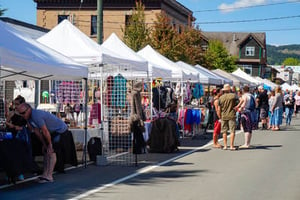Table of contents The foundation of a great event: why vendor quality matters Creating an...
How event organizers can manage vendor placement at events
We know how overwhelming it can be to create an event. But fear not—this event organizer guide will show you actionable ways to make smart decisions about vendor placement at events. By putting vendors close together, you and your team members can create a friendly and exciting environment that helps vendors do well." So, let's ensure your festival management works without harming your event budget!
Categorize Vendors:
Organizing vendors by category for offers tons of benefits. Placing vendors based on their products or services makes for a more successful event. Attendees can then easily find the types of vendors they are interested in. This helps their overall experience, allowing them to explore different offerings.For vendors, being grouped with similar businesses can lead to increased foot traffic and higher sales opportunities. That means vendors are more likely to be satisfied and may be more inclined to promote your event. By organizing vendors by category, event organizers can ensure a well-structured, enjoyable event space for both vendors and attendees alike.
Consider Complementing Products:
Place vendors with complementing products to encourage cross-selling opportunities. For instance, if you have a vendor selling handmade jewelry, consider placing them near a vendor offering unique clothing. This way, attendees interested in fashion may be drawn to both vendors, increasing their chances of making a purchase.This arrangement promotes cross-selling opportunities and inspires attendees to purchase products from multiple vendors that enhance each other. Not only does this boost vendor sales, but it also enriches the event's atmosphere. It fosters a collaborative environment among vendors too. Encouraging longer attendee engagement and increased foot traffic is a win for everyone.
Separate Similar Competitors:
Grouping complementary vendors is important, but keep direct competitors apart. This prevents unnecessary clashes and fosters a more diverse and balanced event atmosphere. You'll reduce the risk of repetitive areas, where attendees may feel overwhelmed with too many options in one spot. This approach also allows each vendor to shine individually and be unique.Attendees will appreciate the variety too. This floorplan design can contribute to a harmonious vendor environment.
Using mapping for your event makes this planning a snap. Eventeny offers easy-to-use mapping that helps you link your artists and vendors directly to the space. It saves hours of work and can easily be used to guide your artists, vendors, and your attendees.
Create Vendor Zones:
Make specific zones within the event based on vendor categories. For example, create a "wellness zone" for yoga studios, massage therapists, and health-conscious products. This process will keep your event flowing sensibly and can keep directly competing vendors from getting a little too close. You will also be able to quickly see what zones are getting the most attention of their target audience.Account for Foot Traffic:
Pay attention to busy areas such as entrances, main stages, or restrooms. These prime locations are excellent spots for vendors offering popular or eye-catching products.Placing vendors in these high-traffic areas to boost their visibility and sales. Then you'll provide attendees with easy access to their favorite products. These spots can be used as rewards for vendors and artists that you want to give a boost to. The added sales due to the busy area will definitely show them you care about their success.
Consider Vendor Needs:
Recognizing that different vendors have varying needs for their booth spaces is essential for event planners. Each vendor comes with a unique set of products, services, and requirements, which directly impact their booth setup and presentation.Proactively plan to accommodate these needs by offering a range of booth sizes and configurations. For instance, food and beverage vendors might require access to electricity and water for cooking, while craft vendors may need more display space. Adequate storage, lighting, and signage provisions are equally important to ensure every vendor can showcase their offerings effectively. Tailoring booth spaces to specific needs creates an inclusive and helpful environment and enhances the overall event experience
Utilize Interactive Spaces:
Set up interactive spaces where vendors can showcase their products or offer demonstrations. These interactive areas can be beneficial for vendors with unique or novel products. Use these spots with different artists and vendors at different times as well. Then you can break up a monotonous area with lively interaction and learning.Monitor and Adjust:
Throughout the event, keep an eye on vendor traffic and interactions. Be prepared to make on-the-spot adjustments. Flexibility is crucial to ensuring vendors have the best possible experience and attendees make the most of the event. You can't plan for everything, but if you're willing to adjust as you go, your event will be at it's best.By zoning vendors, considering complementing products, accounting for foot traffic, and creating vendor zones, you help attendees and vendors. Don't forget to plan for variety, accommodate vendor needs, and seek feedback for continuous improvement. With these simple tips, you'll de-stress event organization and make your events more memorable and enjoyable for all.




